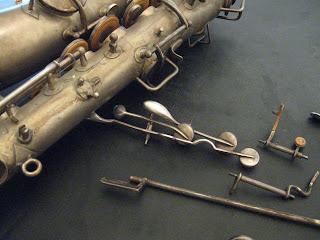The side and palm keys are generally the easiest ones to remove, so they’re coming off first. Also, they are sometimes in the way of the two main key stacks. It’s good to take note now, but order is going to be more important when putting Humpty back together.
The side F# key is removed in this picture. Watch out for those needle springs; they can hurt! - better make sure that Tetanus shot is up to date!
Here are the left hand palm keys, high E and part of the octave mechanism. Note how the shape of the high D# in particular differs from modern horns. It will be interesting to see how ergonomically this instrument will be to play. The mechanism on Buescher horns is pretty consistent from this time through the sixties, so I imagine it won’t feel too unusual. (They are also very similar the original “Bundy” saxophones which were essentially Bueschers stamped with a new name after Selmer acquired the company) Finally, you can see the mangled octave mechanism (second from the bottom, on the right). It shouldn't be too hard to straighten out, just another adventure...
Here’s a Close-up of the low C# key. Behind it, you can see the alternate Eb trill key. This, and the alternate G# trill are to vestiges that do not remain on modern horns. If not set up properly, the Eb in particular can make the action feel “clunky”.
The Left Hand Stack in this case includes the keys for C, B, Bb, A and G. Modern horns generally modeled after Mark VI's keep the Bb and G separate and on pivot screws. The main advantage is that you don't have such a long rod running through so many posts. This can lead to keys binding if things get knocked. Also, it's easier fabricate, take apart and maintain if the entire stack isn't on one rod. With the keys removed, you can see the exposed springs and tone holes.
With so many small parts, its absolutely essential that they are labeled and accounted for. Loosing the wrong one would be akin to loosing a part off of that classic British racing car you’re restoring, not fun.
Pile ′O Keys
Pile ′O Pads
One special feature of old Buescher saxophones is the metal backing on the pads. While most saxophone pads are held in place by shellac, these snap in similarly to flute pads. Apparently they never need seating? Right. These snap pads pose a special challenge for whomever is replacing them. To work properly, the pads must create and air tight seal on the tone holes. Normally, heated shellac on the back of the pad (in the key cup) allows it to be “floated” into place and conform to the tone hole. The key is then held closed and allowed to cool. The shellac hardens and holds the pad in place. In addition to the ridged backing, the snaps make floating the pads more difficult. Since I’ll be using modern pads I’ll have to choose whether to use shellac anyway, or as I have in the past, use paper shims to seat them.
Well, now I have a pile of saxophone parts. Overall, the keys came off very easily, with only a few needing a little WD40 to loosen their screws. Next time, the saxophone gets a bath - seriously.









Why, it is a thing!
ReplyDelete